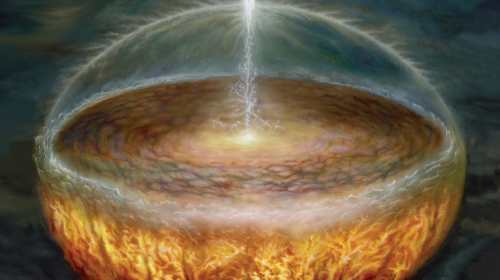 |
| Picture of the Cosmology of Hell from the Book Jacket |
Hell is a topic that most Westerners would rather avoid. Indeed, Sam Bercholz said at his talk I attended on Saturday that when he read Paltrul Rinpoche's Words of My Perfect Teacher, he paged through the descriptions of hell, thinking them to be for Tibetan peasants, and he ignored Dante's Inferno for the Paradiso. But after suffering a massive heart attack at the Palm Springs airport and having a sextuple bypass, Bercholz was in the intensive care ward slowly recovering when he flatlined and literally died. While the medical personnel were frantically trying to revive him, he had a near death experience, but it was not the peaceful, "Tunnel of Light" experience widely reported in the New Age literature. It was an experience of hell.
This book is a collaboration between Bercholz and an extraordinarily talented Tibetan painter from Los Angeles, Pema Namdol Thaye. The book is lavishly illustrated with Thaye's pictures, and Bercholz subtitles the book "A Graphic Memoir", making the comparison with graphic novels and comics. The pictures of hell are in color, while other pictures depicting Bercholz' life, including a previous near death experience in which he experienced the "Tunnel of Light", are in black in white. Hell in Thaye's depiction bifurcates into two, the hot hells - a roiling place of lava, sulfur and smoke where beings are packed so tightly that some beings are parts of others - and the cold hells were everything is frozen, including the beings who ended up there. Bercholz said that the hot hells are where beings end up whose minds tend toward anger and hatred, while the cold hells are those where beings end up whose minds tend toward disdain.
Bercholz and Thaye spent many hours talking about Bercholz's experience but the power of the pictures comes from Thaye's experience of having visited hell too. As a young child in Tibet, Thaye always wanted to paint pictures of hell, and he is one of a small group of "hell travelers", along with Bercholz: those who have visited hell and returned to speak about it. Bercholz says that the only reason he was able to survive the experience was that he was accompanied on his visit by the Buddha of Hell, a compassionate presence who literally held Bercholz in his hands, and Jhana Sophia, the embodiment of wisdom. Bercholz says that even in hell it is possible to become enlightened and escape. The hell dwellers just need to realize compassion for themselves and those suffering around them, and they will see Jhana Sophia and the Buddha of Hell, and be reborn in another, less suffering intensive realm. But the hell dwellers are so caught up in their own anger and distain that they don't see these two beings.
Most of the pictures show hell as a modern cityscape, not the traditional Tibetan architecture nor even the Renaissance landscape of Dante in his Inferno. Bercholz says that before he entered hell, he encountered Yama, the Lord of Death and the embodiment of impermanence, and that Yama was the only aspect of the entire experience that looked like the traditional Tibetan depiction. A long time student of Tibetan Buddhism whose teachers include Choam Trugpa Rinpoche, Bercholz says that after he was revived, he was surprised that hell looked a bit like a big city having expected that it would look like Tibet, but that after some research in the experience of hell in other cultures, people universally experience it in ways that are consistent with their experience in their life.
Bercholz says that this is due to our "habit of space and time". Being dead, you no longer have a body to ground your experience in the material world so the continuity of your mind begins to construct experiences based on your habits during your life. If that includes habitual anger, hatred, and distain, then you will experience hell. Even though the book is structured as a series of vignettes telling the stories of the suffering beings he met in hell, Bercholz is clear that the actual experience was completely nonconceptual. The stories are an attempt to render this deep, nonconceptual experience into the "and then this happened, and then I met this being and she told me her story..." by which humans pass on their experience to each other.
I've personally always been interested in hell, read Dante's Inferno with interest when I was in college, and have been a fan of Hieronymus Bosch's art. The description of the Buddhist hells have also drawn my attention, particularly the "Hell of the Iron Doors", where the suffering being is in a room of hot iron and there are doors open on the four walls, but as they run to escape the room, the door slams shut. What exactly hell is or isn't is another question, but from Bercholz' and others description, something seems to be there. Unfortunately, while his and Thaye's book is a fascinating read, the way such an experience is communicated, through stories, is unlikely to reach the people who really need to hear it, those whose lives are ruled by habitual anger, hatred, and disdain. If they could for one minute experience the intensity of the suffering that they are causing others through an experience of hell (100% suffering, 100% of the time), they would likely reconsider their behavior.
So if you are interested in hell or just want to check out some fabulous contemporary Tibetan art, I'd recommend buying the book.
Image source: forwardreviews.com
